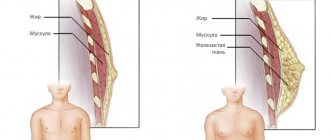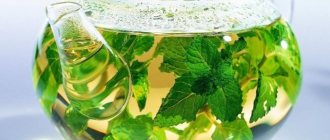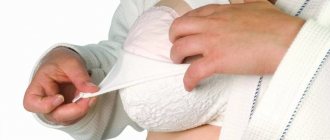??Breast massage for nursing mothers with lactostasis (milk stagnation) ??
The period of breastfeeding cannot be called simple and easy for a young mother; in addition to the banal lack of sleep and fatigue, various unpleasant physiological conditions and pathologies often arise. These are painful cracks in the nipples, insufficient or excessive amounts of milk, stagnation of milk (lactostasis) and, as a result, mastitis.
A woman can cope with most of these troubles on her own, but with lactostasis, and even more so with mastitis, a doctor’s consultation is required. Stagnation of milk without an appropriate reaction turns into mastitis, and this is a serious pathology, fraught not only with the cessation of lactation, but also with serious problems with the woman’s health in the distant future.
Causes of pathology
Stagnation of milk in the breast is not a disease, but a condition in which constantly arriving milk clogs one or more ducts - the so-called milk plug. This causes severe discomfort, which forces some women to even give up feeding their baby in favor of artificial formula.
The occurrence of lactostasis is possible at any stage of breastfeeding, but more often it occurs in the first three weeks after birth, after the end of colostrum production. Then the milk begins to actively flow, but the breasts are not ready for this or the woman is not caring for it correctly.
A sudden flow of milk leads to breast enlargement, often accompanied by pain, the appearance of lumps, and an increase in temperature.
The causes of lactostasis begin in the period before childbirth and in the first weeks of feeding; there are also physiological reasons:
- the woman did not develop her breasts before childbirth;
- milky passages are narrow and short in length;
- flat nipple;
- endocrine disorders;
- mammary gland injuries;
- infrequent breastfeeding;
- the woman herself provokes stagnation by constantly squeezing her breasts in one place during feeding;
- short feeding time from one breast;
- sleeping on your stomach;
- long breaks between feedings (more than 7-8 hours);
- mother's overwork;
- uncomfortable bra;
- expressing the breast until it is completely empty, which causes a sudden supply of new milk, which the baby cannot eat.
But the most important and common reason is the baby’s incorrect attachment to the breast from the first feedings. If a child does not grasp the nipple correctly, then he sucks milk from the same ducts, and some remain inactive, which causes stagnation and blockage of the passages.
To get stagnant milk to circulate, there are several methods that are best used in combination:
- learn how to properly attach the baby, taking into account the place where the stagnation occurred;
- proper expression of leftovers after feeding;
- massage for lactostasis;
- physio- and water treatments;
- correct drinking regime;
- comfortable underwear;
- prevention of lactostasis.
The benefits of massage for mothers during breastfeeding
Breastfeeding is different for each woman. Excess or lack of milk leads to chest discomfort. To relieve tension, doctors recommend massaging the bust, and you should start immediately after childbirth.
The benefits of such procedures are obvious:
- Massage with light movements relaxes the chest muscles and stimulates the functioning of the mammary glands.
- The correct, correctly executed massaging process will help eliminate stretch marks and sagging breasts.
- Massage facilitates the flow of milk from the breast.
- Helps avoid blockage of blood vessels (lactostasis) through which colostrum and subsequently milk flow.
- It improves blood circulation in the mammary glands.
The procedure can be prescribed to almost any nurse: provided all the rules for chest massage are followed, no side effects or allergic reactions occur. Various types of drinks that improve lactation definitely do not have such an unambiguously positive recommendation.
What are the benefits of breast massage?
It is categorically unacceptable to let the appearance of stagnation take its course - it will not resolve on its own, although such a misconception exists. There are two options:
- residual compactions are formed, invisible to the woman, which can subsequently cause mastopathy, the appearance of cysts, benign and malignant tumors;
- infectious inflammation of the mammary gland - mastitis, a dangerous disease in which breastfeeding has to be suspended due to complex treatment with antibiotics and even the need for surgical intervention.
Therefore, at the first manifestations of lactostasis, you should immediately begin to fight this serious problem. One of the most effective methods is breast massage.
Preventive kneading and massaging should begin on the 4th day after the birth of the child, at which time colostrum ceases to be released and milk production begins. It can be performed by a specialist massage therapist, one of the relatives, or the woman herself - while learning the basics of manipulation. A pediatrician or massage therapist at a clinic can teach this.
The benefits of this procedure are as follows:
- breaks up pockets of stagnation and hardening in the chest;
- disperses swelling;
- softens tissues;
- removes milk that has stagnated in the ducts;
- promotes stretching of passages and free circulation of fluid;
- prevents the onset of inflammatory processes;
- stabilizes the process and feeding schedule;
- helps to get rid of panic and fear, to have a positive attitude towards breastfeeding for a longer period of time.
In what cases is massage unacceptable?
You should not massage during lactation if:
- The young mother has skin diseases, for example, dermatitis. Such a disease only spreads further when useful techniques are carried out.
- the body is affected by a cold or infectious disease. Exercise affects blood circulation, which in turn can affect pathogens and contribute to the transmission of the disease to infants.
- there is stress, fatigue, nervous tension. The child can take over the mother’s nervous state, so before starting feeding and performing exercises, it is worth setting yourself in the right mood and resting.
- there is an acute form of inflammation or exacerbation of chronic diseases. Pressing on the corresponding points can aggravate the disease, so it is better not to carry out the procedures.
Massage technique
General requirements for how to do breast massage when lactostasis has developed are as follows:
- session time is 20-30 minutes, 1 or 2 times a day, optimally after morning and evening feedings, before pumping - then you can clearly identify all the seals;
- performed while sitting, with both hands, first on the breast with compaction, then on the second gland (even if there is no stagnation there), then again on the first;
- movements should be smooth, soft, gentle, the direction should be from the periphery of the gland to the nipple (it is forbidden to rub it back - this will force the milk inside, and congestive foci will increase).
Before we describe the massage technique for lactostasis in nursing mothers, let us remind you once again what absolutely cannot be done:
- stop feeding the baby from the affected breast;
- make intense, sharp and strong movements;
- use warm compresses and ointments;
- stop the procedure even if there is a feeling of discomfort.
The algorithm for performing a massage during milk stagnation is as follows:
- lightly warming the chest with a heated diaper or a warm shower;
- smooth rubbing from the edges of the gland towards the nipple;
- take the breast from below with one hand, lift it, massage it clockwise with the other hand, trying to drive the milk to the nipple, express it;
- find lumps by soreness or a red spot (this is how stagnation manifests itself if it is in the deep ducts);
- on this part of the mammary gland, knead, tap, shake;
- again massage the entire gland, driving milk to the nipple, bend over and shake the breast for 30-40 seconds, then express what has collected;
- Finally, dry cold should be applied to the chest (a diaper pre-chilled in the refrigerator, or wrap ice in a bag, then in a towel, or a chilled cabbage leaf).
To facilitate the massage, you can resort to creams and masks, but they should not contain warming ingredients and essential oils (only sage oil is allowed, but on the condition that the baby will not be put to the breast earlier than after 3 hours). The best choice: baby cream or massage oil, Bepanten cream (Pentacrem, Heppiderm), a few drops of olive oil.
In some cases, massaging the breast during congestion causes very severe pain. But you shouldn’t refuse a massage - mastitis is even more painful, and it will take a long time to treat. To reduce pain, doctors recommend performing a massage in the shower at a temperature of 36°C - the water will seem cool and reduce discomfort.
Usually 3-5 massage sessions are enough to eliminate congestion and return the breasts to normal.
But, if the pain increases, or the milk contains an admixture of blood or yellow pus with an unpleasant odor, you should immediately consult a doctor who will prescribe a course of treatment so as not to trigger inflammation.
Preventive massage
Based on the name, it is easy to understand that the massage procedure for the female breast in this case is prescribed to prevent diseases associated with stagnation of milk, or its lack in the first postpartum days.
Important! Preventive massage is done slowly and smoothly.
A general diagram of how to do breast massage is presented here:
- One palm rests just below the collarbone, supporting the chest. The second - working - rests on top.
- Using smooth strokes in a circle, move from the base of the bust to the nipple.
- Then move on to the décolleté area – slowly and gently stroke the breasts from top to bottom.
- Lean forward and shake your breasts slightly - milk outflow will be activated.
- Also gently knead and slightly pull the nipples - this will avoid unwanted cracks.
- Finish the session with hydromassage - take a warm shower.
It is believed that proper breast massage is an effective aid in improving milk flow. And it is preferable to other options (for example, tea to enhance lactation) because at the time of massage, metabolic processes in the mammary glands are accelerated, which significantly improves milk flow.
Doctors recommend starting preventive massage on the second day after birth. And first you should massage the upper back and neck.
The procedure is performed while sitting, so you should ask your family for help.
How to express milk correctly
The procedure for freeing the glands from milk residues after feeding is relevant for most mothers. Some people have an excess of milk and because of this, stagnation is possible, while others have little milk and regular pumping stimulates an increase in its production.
Previously, young mothers were taught that it was necessary to express the rest of the milk after each feeding, “dry” - until the last drop. Now the concept has changed: pumping should only be done under certain conditions:
- if the baby sucks sluggishly, inactive or weak;
- with milk deficiency;
- with excessive production;
- if you need to stock up (travel, medication treatment).
You can perform the manipulation with your hands or use a breast pump; the dishes can be any with a non-slip bottom.
There are several techniques for effectively expressing milk.
Marmet technique. Pumping is performed while sitting, leaning on the back of a chair. You need to hold the milk container with your left hand, grab the gland with your right hand and gently press on the areola with your thumb and forefinger, moving them in the direction of the nipple.
Heated bottle technique. It is recommended to be used when the nipples are too large or tense and the baby cannot fully grasp them. In this case, you need to take a jar with a neck of 4-6 cm, heat the top in hot water, and cool the bottom. The areola should be lubricated with oil and placed in a bottle. The temperature difference will increase the milk and when it begins to come out easily, the bottle must be removed and further expressed by hand.
Breast pump. This device, regardless of design, effectively selects milk with minimal participation from the woman. There is only one subtlety in choosing a breast pump: the diameter of its funnel should be 1-2 cm larger than the diameter of the areola. And during manipulation, the vacuum level must be selected based on personal feelings so that there is no pain or discomfort.
How to express milk during stagnation?
If, despite all the steps taken, the baby still cannot cope with the resorption of stagnation, you need to try to express the milk yourself. In rare cases, even a breast pump may work.
But it’s more effective with your hands. However, there is no need to press with all your might on the stagnation. This is very painful and traumatizes the breast tissue. The World Health Organization does not recommend using this method in its materials!
The technique of pressing your fingers on the areola works great. It's called the Marmet pumping technique:
Place your fingertips on the border of the areola and white skin, in line with the nipple. For example, first from above and below the nipple. We press towards the ribs, and then begin to move our fingers towards each other and a little forward. Fingers should not slip on the skin! They should stand in one area and move with the breast tissue. There is also no need to pull the nipple forward. (See video at the end of the article). To enhance the effect with less pressure on the areola, you need to rest the base of the hand on the chest, and not keep your hand suspended.
To make pumping more effective, you should think about relaxing and drink a cup of warm drink first, or get under a warming shower - it is better to direct it not on the chest, but on the neck and back. You can also steam your feet.
Physiotherapy procedures
Along with massage, hardware physiotherapy is often prescribed for large and painful lumps. This accelerates the processes of resorption of stagnant lesions, gives an analgesic, anti-edematous effect, and relieves spasms.
The most effective techniques:
- Ultrasound massage and ultrasound intensity 0.2-0.4 W/cm2. The duration of the daily procedure is up to 5 minutes, the woman does not feel any discomfort. Already after 3-4 procedures there is a noticeable improvement.
- MI - pulsed magnetic therapy is performed once a day, a course of 507 sessions, the procedure lasts up to 7 minutes.
- DM and SM therapy is the irradiation of affected areas with waves of 8-10 W. The duration of the procedure is up to 10 minutes, the course is 8-10 days.
There are strict restrictions on the use of physiotherapeutic methods:
- mastitis and mastopathy;
- fibroadenoma of the mammary glands;
- benign and malignant tumors of the breast and lymphatic system;
- diseases of the central nervous system;
- presence of a pacemaker.
General rules for massage
- A breast massage session to increase lactation lasts no more than 10 minutes. It is carried out between feedings.
- Movements must be extremely careful and smooth so that the woman does not experience any discomfort.
- If there are painful areas on the organ (swelling, congestion), then they need to be given more attention, and after the massage, apply a cold compress there (this promotes the outflow of lymph).
- You should not stretch the skin during the procedure. To avoid chafing, you should use special moisturizing oils, avoiding contact with the nipple (by the way, the beneficial substances in their composition fight stretch marks).
- During the massage, hygiene rules are mandatory.
Video: breast massage technique
Water activities
To prevent and eliminate stagnation of milk in the breast, water massage is also used. It can be used at home in the form of a contrast shower with a slight temperature difference.
In a clinical setting, the following types are prescribed:
- underwater shower-massage;
- circular shower;
- Charcot's shower.
How to prepare your breasts for feeding before birth
The main problem associated with breastfeeding is cracked nipples. Open cracks and wounds are gateways for germs and infection. In addition, this is a very painful phenomenon, but it can be prevented. To do this, during pregnancy, even before giving birth, you need to prepare your nipples for the upcoming “work”.
- Friction.
Rub your nipples with a towel for five minutes. This will slightly roughen the nipple skin and make it stronger. If rubbing your nipples with a towel causes you pain and discomfort, you can slightly modify this process. Cut two circles from terry cloth and sew them into the bra at nipple level. Such relaxed and light friction during prolonged and regular wearing of underwear will perfectly prepare the breasts for feeding. - Compresses.
To make your nipples slightly rougher and your skin less sensitive, you can make compresses from black tea or oak bark. Brew strong black tea and soak cotton pads in it. Apply damp cotton pads to your breasts, cover the top with film and put on a bra. Leave the black tea compress for 15-20 minutes. Instead of tea, you can use oak bark. The bark is crushed and poured with boiling water, simmered over low heat, and then infused for several more hours. A compress for the nipples is made from the warm broth. Oak bark and black tea contain a large amount of tannins, which make the skin of the nipples rougher, harder and more elastic. - Massage.
To prepare the breasts for feeding, open the milk ducts and soften the gland, you need to do a light, delicate massage on the breasts every day. The massage will soften the breasts so that when milk appears in it, it will be easily sucked out by the baby. The massage should consist of stroking, patting and pinching movements. First, use circular light pressure to massage the skin around the nipple. Then, with both hands, rub the mammary gland from the armpit towards the nipple. After this, we lightly press on top and bottom of the breast, as if we want to express milk. All these movements should not bring pain or discomfort - everything is gentle, soft, delicate. Massage should be done every day starting two months before the expected date of birth. - Hardening.
This is an essential part of preparing the nipple for feeding. So that the skin is not so thin and vulnerable, the nipple needs to be hardened. To begin with, you can carry out air baths. Walk for some time without underwear at home or outdoors. But be careful - it is not advisable to expose nipples to direct sunlight. Along with air baths, water hardening can be carried out. Every day after showering, direct a stream of warm or cool water to your nipples. Gradually, every day, as your skin gets used to cold water, reduce the temperature by one degree. You should not douse yourself with excessively cold water; do not lose common sense.
We are all different, like our figures, faces and souls. Likewise, the shape of each woman’s nipple has its own characteristics. Even before giving birth, a woman needs to evaluate the shape of her nipple. The nipple may be convex, which makes breastfeeding easier for the baby. If the nipple is flat or internal, the child cannot grasp it and sucking becomes problematic. Often babies refuse to suckle at such a breast, cry incessantly and mothers are forced to transfer the child to artificial feeding. This can be avoided by preparing your breast shape for feeding in advance.
First you need to determine what shape your nipple is. To do this, lightly pinch it between two fingers. The fingertips should be on the border of the areola. If at the same time the nipple jumps out, it means it is convex, and if it hides inward, it means it is retracted.
If you have an inverted nipple, you need to carefully pull the nipple out with your hands, as if twisting it around its axis. Don't overdo it - overstimulation of the nipples can lead to premature labor
The pharmacy has special vacuum pads that artificially pull the nipple out. They need to be worn for half an hour every day before giving birth. Such covers will also come in handy after childbirth; they will need to be put on 10 minutes before feeding to prepare the nipple and make it easier for the baby to suck.
Prevention of milk stagnation
Preventive measures are not complicated and every woman, using them in full, can avoid lactostasis. The recommendations are:
- positive attitude;
- preparation and regular self-massage of the breast;
- frequent feeding at the baby's request, and not according to the clock;
- duration of feedings - how much the baby needs;
- warm shower before feedings;
- expressing milk as needed;
- a properly selected bra for nursing mothers;
- sufficient drinking regime;
- quality rest and sleep.
A problem such as stagnation of milk in the breast reduces the quality of life of the mother and the nutrition of the baby. If you consistently follow simple rules of prevention, then avoiding lactostasis is not difficult. And if symptoms of stagnation appear, it is best to consult a family doctor or pediatrician and adhere to the prescribed measures - this way, in 2-4 days you can completely return to a healthy state and avoid serious complications.
Results
In order to maintain normal health, and feeding becomes comfortable not only for the child, but also for the mother, you must adhere to the following rules:
- Forget about a hot shower and especially a bath. Avoid overheating the mammary glands.
- You cannot limit your drinking regime.
- Be sure to have a balanced diet rich in vitamins B (iron) and C.
- Under no circumstances should you stop breastfeeding, even if symptoms of milk stagnation appear.
- A daily massage of the shoulder and chest glands will relax the muscles that are tense during the day.
And, of course, go to the hospital in a timely manner for examination, even if the cause for concern seems minimal. Obstetricians and gynecologists will definitely tell and show how to properly massage breasts for nursing mothers.
How to properly develop thoracic ducts for feeding
Cabbage leaves effectively help relieve painful sensations.
Before you begin pumping your breasts, you need to carefully prepare the mammary glands for the upcoming procedure. Otherwise, you will not be able to achieve a good result.
There should be no difficulties in preparation. It is enough to follow a few simple rules:
- 10-15 minutes before the procedure, you need to warm your breasts with a warm heating pad, towel or take a bath. A heating pad or water that is too hot can provoke an inflammatory process and leave burns on the skin.
- It is effective to use centuries-old traditional medicine recipes, for example, applying a cabbage leaf to the chest. First, the leaf is beaten so that the medicinal juice begins to stand out. This poultice relieves pain and makes glandular tissue softer and more pliable.
- Massage for the sternum for nursing mothers also allows you to effectively cope with the task. The main thing is to learn how to do it correctly, otherwise you can injure your chest. Movements should be smooth and careful, without excessive squeezing.
Warming up the mammary glands is possible only if the woman does not have an elevated body temperature. If the readings are slightly higher than normal, warming up should be abandoned.
If a woman is afraid to perform any manipulations on her own at home, you can contact a mammologist or gynecologist. Ultrasound or UHF therapy will be prescribed as preparatory procedures.
Why is lactation decreasing?
The most common reasons for decreased milk supply are:
- Irregular or poor nutrition of a nursing mother;
- Stress, worries, negative emotions;
- Chronic lack of sleep;
- Bad habits;
- Lactation crises.
In addition to these reasons, there are many nuances that affect milk production. For example, a mother eats well, gets enough sleep, has no bad habits, but the amount of milk still decreases. Maybe her body is in the process of a so-called lactation crisis? It is well known that the body of a nursing mother after childbirth experiences 3 crises: on the 3-10th day after the birth of the baby, on the 20-30th and on the 3rd month. This hormonal change can be dangerous for lactation and the quality of breast milk.
Another nuance is to drink plenty of fluids. Most women forget that they not only need to eat well, but also drink plenty of fluids. It plays an important role in milk production and can increase lactation. Few people know that there are products that inhibit the process of milk production. These include smoked, spicy foods, seasonings for dishes, and flour products.
So, the reasons for the decrease in milk supply are known. Now let's look at how to increase lactation and improve the quality of breast milk.
Benefits of breast massage for pregnant women and mothers
Impact on the mammary glands with massage movements after childbirth helps solve and prevent a large number of problems:
- massage improves blood circulation in tissues;
- prevents the appearance of stretch marks;
- improves skin tone;
- increases the amount of milk secretion and promotes easier milk flow;
- minimizes the likelihood of developing lactostasis;
- helps eliminate milk stagnation;
- promotes easy completion of breastfeeding.
Preparing for the session
Breast massage for lactation should not only be effective, but also safe. Therefore, you should worry about preparing for the session in advance. Particular attention must be paid to body and hand hygiene before starting the procedure to avoid possible infection. This is especially true when there are cracks in the nipples.
Typically, any massage manipulation is carried out in about 10-15 minutes. before feeding the baby. However, in each specific case, depending on the purposes for which the massage is performed, the time period may vary.
Most experts recommend lightly expressing milk before a massage session. This can easily be done using a breast pump or manually.
It is necessary to decide in advance on the massage technique and study it well. Only after this, with clean hands, can you proceed to the massage procedure. While still in the maternity hospital, a woman is recommended to consult with a gynecologist or breastfeeding specialist about the presence of contraindications to breast massage.










